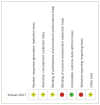Is Bleaching Effective in Managing Post-orthodontic White-spot Lesions? A Systematic Review
- PMID: 32051965
- PMCID: PMC11654630
- DOI: 10.3290/j.ohpd.a44113
Is Bleaching Effective in Managing Post-orthodontic White-spot Lesions? A Systematic Review
Abstract
Purpose: White spot lesions (WSL) are common side-effects of orthodontic treatment with fixed multi-bracketed appliances. The aim of this review was to find all available literature and critically assess the evidence for the efficacy of bleaching as a method to treat or alleviate post-orthodontic WSLs in permanent teeth.
Materials and methods: Electronic databases were screened for relevant literature with the aid of predetermined search strategies. All types of studies, including randomised or nonrandomised controlled trials (RCTs or CCTs), prospective and retrospective studies, as well as in vitro studies were considered eligible for inclusion. The reference lists of all included articles were hand searched for additional studies. Two authors independently performed study selection, data extraction, and risk of bias assessment.
Results: One RCT and 8 in vitro studies met the inclusion criteria. Seven studies were classified as having a high risk of bias while 2 in vitro studies were graded as having a moderate risk of bias. The results showed that bleaching of WSL can diminish colour disparities between carious and non-affected areas, but the certainty of the evidence was very low. The high degree of methodological heterogeneity precluded a valid interpretation of the results through pooled estimates.
Conclusions: The findings from the present systematic review could not support or refute bleaching as an effective method for management of post-orthodontic WSLs. Because most of the studies in this field are in vitro and solid scientific evidence of low risk of bias is scare, further prospective in vivo studies are necessary.
Keywords: bleaching; enamel demineralisation; fluoride; tooth whitening; white spot lesions.
Figures
References
-
- Ahn SJ, Lee SJ, Lim BS, Nahm DS. Quantitative determination of adhesion patterns of cariogenic streptococci to various orthodontic brackets. Am J Orthod Dentofac Orthop. 2007;132:815–821. - PubMed
-
- Alves EA, Alves FK, Campos Ede J, Mathias P. Susceptibility to carieslike lesions after dental bleaching with different techniques. Quintessence Int. 2007;38:e404–409. - PubMed
-
- Attin T, Kielbassa AM, Schwanenberg M, Hellwig E. Effect of fluoride treatment on remineralization of bleached enamel. J Oral Rehabil. 1997;24:282–286. - PubMed
-
- Attin T, Schmidlin PR, Wegehaupt F, Wiegand A. Influence of study design on the impact of bleaching agents on dental enamel microhardness: a review. Dent Mater. 2009;25:143–157. - PubMed
Publication types
MeSH terms
LinkOut - more resources
Full Text Sources
Medical
Miscellaneous




